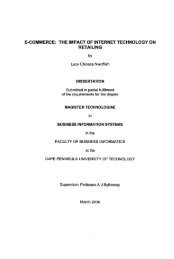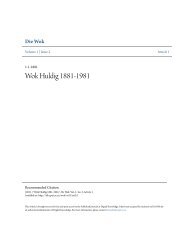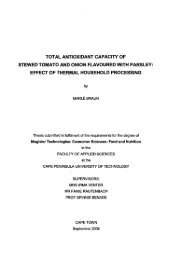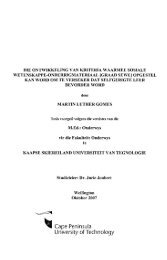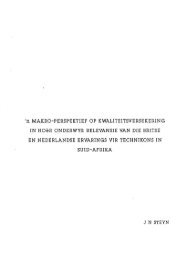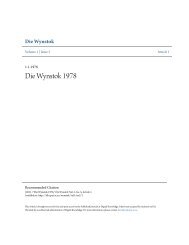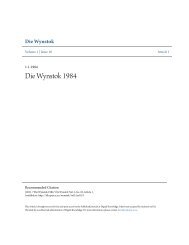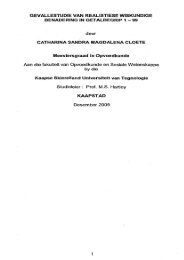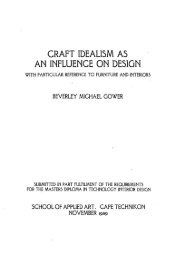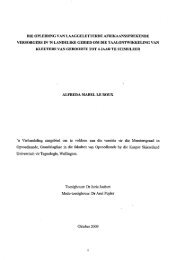the effect of the particle size distribution on non-newtonian turbulent ...
the effect of the particle size distribution on non-newtonian turbulent ...
the effect of the particle size distribution on non-newtonian turbulent ...
Create successful ePaper yourself
Turn your PDF publications into a flip-book with our unique Google optimized e-Paper software.
ABSTRACT<br />
THE EFFECT OF THE PARTICLE SIZE<br />
DISTRIBUTION ON NON-NEWTONIAN<br />
TURBULENT SLURRY FLOW IN PIPES<br />
The handling <str<strong>on</strong>g>of</str<strong>on</strong>g> solid-liquid suspensi<strong>on</strong>s is an important c<strong>on</strong>cern within <str<strong>on</strong>g>the</str<strong>on</strong>g> chemical and<br />
processing industries and many <str<strong>on</strong>g>the</str<strong>on</strong>g>oretical models have been proposed to try and explain and<br />
predict <strong>turbulent</strong> flow behaviour. However, <str<strong>on</strong>g>the</str<strong>on</strong>g> predicti<strong>on</strong> <str<strong>on</strong>g>of</str<strong>on</strong>g> <strong>turbulent</strong> flow from <strong>on</strong>ly <str<strong>on</strong>g>the</str<strong>on</strong>g><br />
viscous properties <str<strong>on</strong>g>of</str<strong>on</strong>g> n<strong>on</strong>-Newt<strong>on</strong>ian suspensi<strong>on</strong>s has over <str<strong>on</strong>g>the</str<strong>on</strong>g> years been questi<strong>on</strong>ed by<br />
researchers. This <str<strong>on</strong>g>the</str<strong>on</strong>g>sis c<strong>on</strong>siders <str<strong>on</strong>g>the</str<strong>on</strong>g>oretical models well established in <str<strong>on</strong>g>the</str<strong>on</strong>g> literature and<br />
<str<strong>on</strong>g>the</str<strong>on</strong>g> Slatter model, which uses both <str<strong>on</strong>g>the</str<strong>on</strong>g> rheology <str<strong>on</strong>g>of</str<strong>on</strong>g> <str<strong>on</strong>g>the</str<strong>on</strong>g> suspensi<strong>on</strong> and <str<strong>on</strong>g>the</str<strong>on</strong>g> <str<strong>on</strong>g>particle</str<strong>on</strong>g> <str<strong>on</strong>g>size</str<strong>on</strong>g><br />
<str<strong>on</strong>g>distributi<strong>on</strong></str<strong>on</strong>g> <str<strong>on</strong>g>of</str<strong>on</strong>g> <str<strong>on</strong>g>the</str<strong>on</strong>g> solids. These models are used to analyze <str<strong>on</strong>g>the</str<strong>on</strong>g> experimental data and <str<strong>on</strong>g>the</str<strong>on</strong>g><br />
<str<strong>on</strong>g>effect</str<strong>on</strong>g> that <str<strong>on</strong>g>particle</str<strong>on</strong>g> <str<strong>on</strong>g>size</str<strong>on</strong>g> and <str<strong>on</strong>g>the</str<strong>on</strong>g> <str<strong>on</strong>g>particle</str<strong>on</strong>g> <str<strong>on</strong>g>size</str<strong>on</strong>g> <str<strong>on</strong>g>distributi<strong>on</strong></str<strong>on</strong>g> has <strong>on</strong> <strong>turbulent</strong> flow behaviour.<br />
The literature c<strong>on</strong>cerning <str<strong>on</strong>g>the</str<strong>on</strong>g> rheological fundamentals relevant to fluid flow in pipes has<br />
been examined. The Newt<strong>on</strong>ian <strong>turbulent</strong> flow model as well as <str<strong>on</strong>g>the</str<strong>on</strong>g> n<strong>on</strong>-Newt<strong>on</strong>ian models<br />
<str<strong>on</strong>g>of</str<strong>on</strong>g>Dodge & Metzner, Torrance, Kemblowski & Kolodziejski, Wils<strong>on</strong> & Thomas and Slatter<br />
have been reviewed.<br />
Test work was c<strong>on</strong>ducted at <str<strong>on</strong>g>the</str<strong>on</strong>g> University <str<strong>on</strong>g>of</str<strong>on</strong>g> Cape Town's Hydrotransport Research<br />
Laboratory using a pumped recirculating pipe test rig. The test apparatus has been fully<br />
described and calibrati<strong>on</strong> and test procedures to enable collecting <str<strong>on</strong>g>of</str<strong>on</strong>g> accurate pipeline data<br />
have been presented. Three slurries were used in test work namely kaolin clay, mixture I<br />
(kaolin clay and rock flour) and mixture 2 (kaolin clay, rock flour and sand) with ad,s<br />
<str<strong>on</strong>g>particle</str<strong>on</strong>g> <str<strong>on</strong>g>size</str<strong>on</strong>g> ranging from 24/Lm to 170/Lm.<br />
The yield pseudoplastic model has been used to model and predict <str<strong>on</strong>g>the</str<strong>on</strong>g> laminar flow <str<strong>on</strong>g>of</str<strong>on</strong>g> <str<strong>on</strong>g>the</str<strong>on</strong>g><br />
suspensi<strong>on</strong>s that were tested and <str<strong>on</strong>g>the</str<strong>on</strong>g> meth9J adopted by Neill (1988) has been used to<br />
determine <str<strong>on</strong>g>the</str<strong>on</strong>g> rheological c<strong>on</strong>stants. The pipeline test results have been presented as pseudoshear<br />
diagrams toge<str<strong>on</strong>g>the</str<strong>on</strong>g>r with <str<strong>on</strong>g>the</str<strong>on</strong>g> <str<strong>on</strong>g>the</str<strong>on</strong>g>oretical model lines providing a visual appraisal <str<strong>on</strong>g>of</str<strong>on</strong>g> <str<strong>on</strong>g>the</str<strong>on</strong>g><br />
performance <str<strong>on</strong>g>of</str<strong>on</strong>g> each model. The Slatter model predicts <str<strong>on</strong>g>the</str<strong>on</strong>g> test data best with <str<strong>on</strong>g>the</str<strong>on</strong>g> o<str<strong>on</strong>g>the</str<strong>on</strong>g>r<br />
<str<strong>on</strong>g>the</str<strong>on</strong>g>oretical models that were c<strong>on</strong>sidered tending to under predict <str<strong>on</strong>g>the</str<strong>on</strong>g> head loss. The reas<strong>on</strong><br />
<str<strong>on</strong>g>the</str<strong>on</strong>g> Slatter model performs better than <str<strong>on</strong>g>the</str<strong>on</strong>g> o<str<strong>on</strong>g>the</str<strong>on</strong>g>r <str<strong>on</strong>g>the</str<strong>on</strong>g>oretical models is because this model can<br />
account for <str<strong>on</strong>g>the</str<strong>on</strong>g> wall roughness and <str<strong>on</strong>g>particle</str<strong>on</strong>g> roughness <str<strong>on</strong>g>effect</str<strong>on</strong>g>. Evidence to support this<br />
statement has been presented.<br />
This <str<strong>on</strong>g>the</str<strong>on</strong>g>sis highlights <str<strong>on</strong>g>the</str<strong>on</strong>g> fact that <str<strong>on</strong>g>the</str<strong>on</strong>g> <str<strong>on</strong>g>particle</str<strong>on</strong>g> <str<strong>on</strong>g>size</str<strong>on</strong>g> <str<strong>on</strong>g>distributi<strong>on</strong></str<strong>on</strong>g> is a vitally important property<br />
<str<strong>on</strong>g>of</str<strong>on</strong>g> <str<strong>on</strong>g>the</str<strong>on</strong>g> suspensi<strong>on</strong> and that it does influence <strong>turbulent</strong> flow behaviour. It shows that<br />
turbulence modelling using <str<strong>on</strong>g>the</str<strong>on</strong>g> <str<strong>on</strong>g>particle</str<strong>on</strong>g> roughness <str<strong>on</strong>g>effect</str<strong>on</strong>g> (eg Slatter, 1994) is valid and can<br />
be adopted for n<strong>on</strong>-Newt<strong>on</strong>ian slurries. It is c<strong>on</strong>cluded that <str<strong>on</strong>g>the</str<strong>on</strong>g> <str<strong>on</strong>g>particle</str<strong>on</strong>g> <str<strong>on</strong>g>size</str<strong>on</strong>g> <str<strong>on</strong>g>distributi<strong>on</strong></str<strong>on</strong>g> must<br />
be used to determine <str<strong>on</strong>g>the</str<strong>on</strong>g> <str<strong>on</strong>g>particle</str<strong>on</strong>g> roughness <str<strong>on</strong>g>effect</str<strong>on</strong>g> and this <str<strong>on</strong>g>effect</str<strong>on</strong>g> must be incorporated in <str<strong>on</strong>g>the</str<strong>on</strong>g><br />
<strong>turbulent</strong> flow analysis <str<strong>on</strong>g>of</str<strong>on</strong>g> n<strong>on</strong>-Newt<strong>on</strong>ian slurries.




